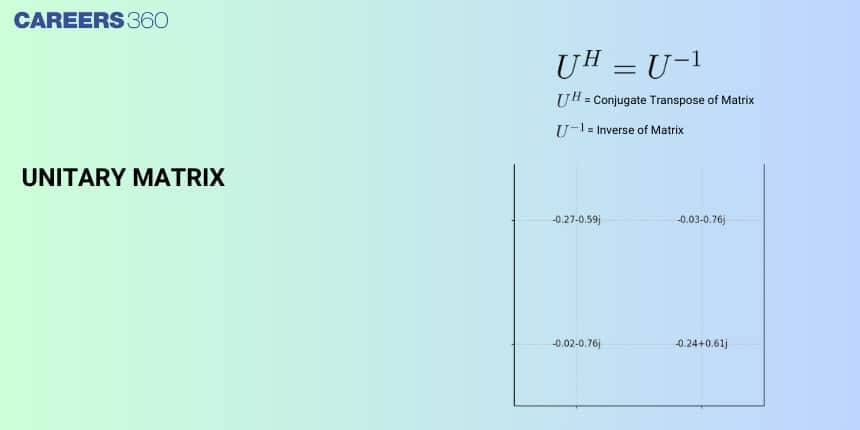Unitary matrix
A matrix (plural: matrices) is a rectangular arrangement of symbols along rows and columns that might be real or complex numbers. Thus, a system of m x n symbols arranged in a rectangular formation along m rows and n columns is called an m by n matrix (which is written as m x n matrix). There are special types of matrices like Orthogonal matrices, Unitary matrices, and Idempotent matrices. In real life, we use unitary matrices in quantum mechanics.
JEE Main: Study Materials | High Scoring Topics | Preparation Guide
JEE Main: Syllabus | Sample Papers | Mock Tests | PYQs
- Square matrix
- Unitary matrix
- Properties of Unitary Matrices
- Solved Examples Based on Unitary Matrix

In this article, we will cover the concept of unitary matrices. This category falls under the broader category of Matrices, which is a crucial Chapter in class 12 Mathematics. It is not only essential for board exams but also for competitive exams like the Joint Entrance Examination(JEE Main) and other entrance exams such as SRMJEE, BITSAT, WBJEE, BCECE, and more. A total of twelve questions have been asked on this topic in JEE MAINS(2013 - 2023) including one in 2021 and one in 2023.
Square matrix
The square matrix is the matrix in which the number of rows = number of columns. So a matrix
E.g.
Unitary matrix
A unitary matrix is a square matrix of complex numbers, whose inverse is equal to its conjugate transpose.
The product of a unitary matrix and the conjugate transpose of a unitary matrix is equal to the identity matrix.
Let A be a square matrix, and if AAH = I, where I is the identity matrix, then A is said to be a unitary matrix, and AH is its conjugate transpose.
Properties of Unitary Matrices
If A is unitary matrices, I is identity matrices, A-1 is the Inverse of matrix A, and AH is the conjugate transpose of matrix A.
1) If A AH = I, then A-1 = AH
2) If A and B are unitary, Then AB is also unitary.
3) If A is unitary, then A-1 and AH are also unitary.
4) A AH = AH A= I
5) A unitary matrix is a non-singular matrix.
6) The determinant of the unitary matrix is not equal to zero.
7) The inverse of a unitary matrix is another unitary matrix.
8) A matrix is unitary, if and only if its transpose is unitary
9) The unitary matrices can also be non-square matrices but have orthonormal columns and rows.
10) The sum or difference of two unitary matrices does NOT need to be a unitary matrix. For example, if A is a unitary matrix, then A - A = O (null matrix), which is NOT unitary.
Recommended Video Based on Unitary Matrix
Solved Examples Based on Unitary Matrix
Example 1: Which of the following properties is true for a unitary matrix
1)
2) The columns of
3) The determinant of
4)
Solution:
1) False. For a unitary matrix
2) True. The columns (and rows) of a unitary matrix are orthonormal vectors.
3) False. The determinant of a unitary matrix has an absolute value of 1, not zero.
4) False. For a unitary matrix,
Hence, the answer is option 2.
Example 2: If the matrix
1)
2)
4)
3)
Solution
Hence, the answer is option 1.
Example 3: If
A) 0
B) 1
C) -1
D) 1 or -1
Solution:
For a unitary matrix
Hence, the answer is option 4.
Example 4:
1)Nilpotent Matrix
2)Unitary Matrix
3)Symmetric Matrix
4)Skew-Symmetric Matrix
Solution
Let
Then
Multiplying both the matrices, we get:
Thus, it is a unitary matrix.
Hence, the answer is the option (2).
Example 5: If A and B are unitary matrix. Then which of the following option is True.
1) A+B is unitary matrix.(always)
2) A-B is unitary matrix. (always)
3) AB is a unitary matrix.(always)
4) (1) and (3) both
Solution:
As we have learnt
Unitary matrix -
(a)
(b)
(c)
Hence, the answer is option 4.
Frequently Asked Questions (FAQs)
A unitary matrix is a square matrix of complex numbers, whose inverse is equal to its conjugate transpose. The product of a unitary matrix and the conjugate transpose of a unitary matrix is equal to the identity matrix.
Yes, the unitary matrices can also be non-square matrices but have orthonormal columns and rows.
No, the sum or difference of two unitary matrices does NOT need to be a unitary matrix. For example, if A is a unitary matrix, then A - A = O (null matrix), which is NOT unitary.
A unitary matrix is a non-singular matrix. A square matrix is called a non-singular matrix if its determinant is not 0. Let's say A is a square matrix then it is non-singular if |A| ≠ 0.
Yes, If A is a unitary matrix then its its conjugate transpose and inverse are also unitary matrices.
Also Read
15 Feb'25 11:01 AM
15 Feb'25 10:43 AM
14 Feb'25 12:44 PM
14 Feb'25 12:41 PM
14 Feb'25 11:14 AM
14 Feb'25 11:08 AM
14 Feb'25 11:02 AM
14 Feb'25 10:58 AM
14 Feb'25 10:55 AM
14 Feb'25 10:43 AM

